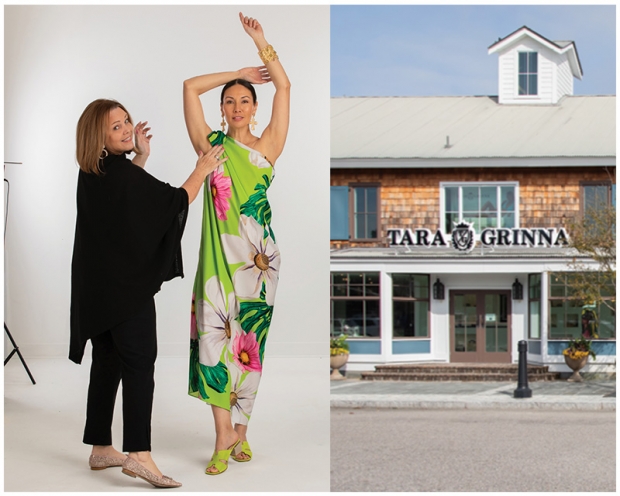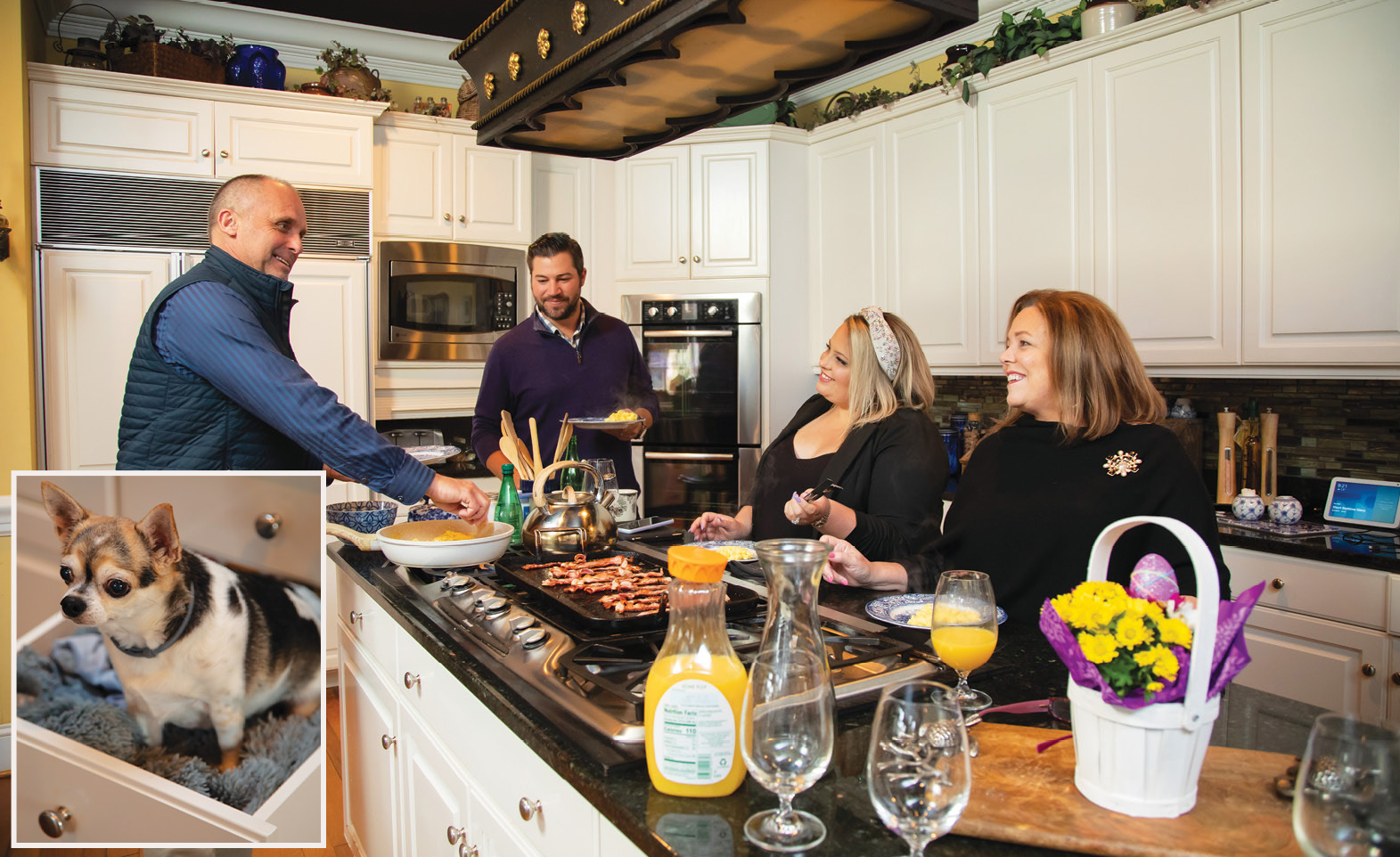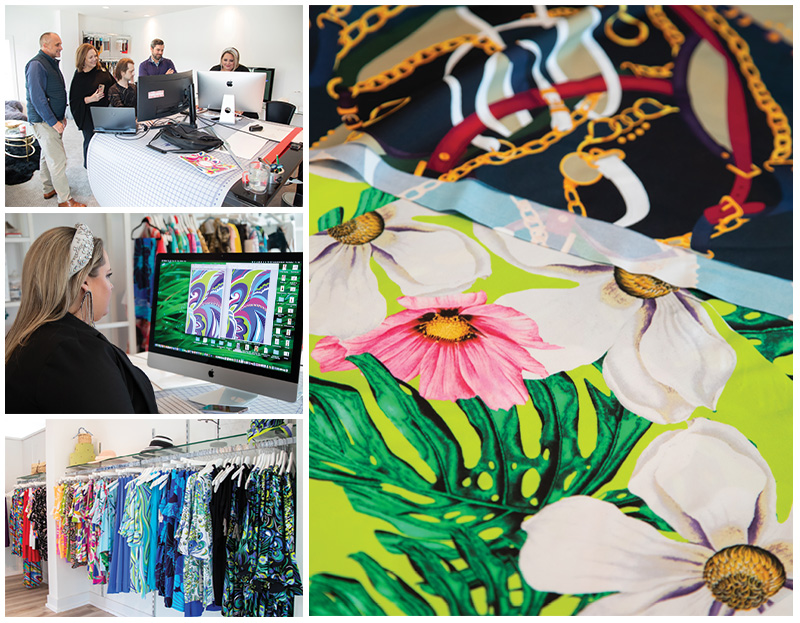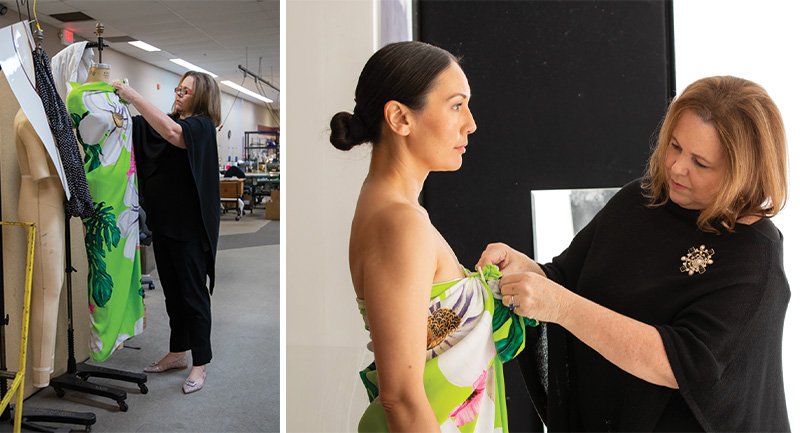A Day in the Life of Designer Tara Grinna

For more than 30 years, ladies with high standards who dread the annual shop-for-a-swimsuit trip have relied on entrepreneur and internationally known designer, Tara Grinna, to deliver and ease their apprehension, With bold prints and an eye for women of all ages and sizes, Tara Grinna Swimwear, specializing in swim separates, resort wear and accessories, was destined to make a splash across the U.S. and the Islands of the Caribbean, which is exactly what the locally owned company has managed over three decades—even through a pandemic, when trips to the beach or poolside were curtailed by so many.
The Grinna family—and the venture is a family affair—have quietly and steadily built a design, manufacturing, distribution and retail business that moves some 500-700 swimsuits and resort wear pieces each week. Tara Grinna exclusive locations are found in nearby Barefoot Landing in North Myrtle Beach, Pawleys Island, on trendy King Street in Charleston, two stores in Florida, including a brand-new location in Palm Beach, another in California, as well as a factory outlet in Conway. With additional retailers selling Tara Grinna products around the U.S. and in the Caribbean, and through a number of online retailers, the Grinnas have made their fashionable mark, putting Conway and the Grand Strand on the international designer’s map. New brick and mortar corporate Tara Grinna retail locations are in the works, while other garment retailers are trimming down their number of stores.
With a bona fide fashion swimwear institution and her leading lady, Tara Grinna, so close to home, we wondered what a typical day (if there is such a thing) might be for this hardworking woman and her family, which includes her fun-loving husband Rune Grinna (pronounced roo-knee), industrious daughter Kirsti Kelliher and Jack-of-all-trades son-in-law Brendon Kelliher. We were granted a rare inside look at just what goes on behind the scenes to keep this beachy enterprise and its more than 40 employees afloat, and it starts with breakfast.
9:00 a.m.

Meeting Tara Grinna and her family for the first time, it’s obvious that work starts early. Morning phone calls to Italy are a nearly daily occurrence, and texts and emails from key players managing the many facets of this complicated business require attention, even as Rune regularly takes on kitchen duties.
On this day, he prepares a breakfast of bacon and eggs at the couple’s Plantation Point home in Myrtle Beach. After breakfast, Rune offers up a medley of Norwegian folk songs on the accordion, an instrument he started playing as a boy in his native Norway. I’m told he doesn’t always play each day after breakfast, but the accomplished musician is not shy in entertaining whoever will listen.
Several furry friends in the Grinna household make their presence known and demand attention. An 11-year-old rescue Chihuahua, Franie, often holds court from her special perch in a towel-lined kitchen drawer while the family congregates each morning, today being no exception. Grinna had already been on the phone with fabric houses in Italy, as the time difference makes it imperative to reach them early.
“If I don’t get my Italian work done by noon, I’ve missed them,” she says. “They’ve been hit so hard by the pandemic. Italy has really suffered. Some of the [fabric houses] have closed–probably permanently–and the rest are holding on waiting for things to improve. Our Charleston store was the hardest hit by the pandemic. The hotel next to it drives in a lot of traffic; we’re really dependent on them. The hotel was closed completely until the last weekend in June [2020]. As bad as it was, Charleston is now our best store.”
There are currently seven Tara Grinna corporate retail stores, with more on the way, and some 20 or so retailers around the U.S. and Caribbean that stock and sell her designer items.
9:45 a.m.
“Once we eat breakfast, we go,” says Grinna, snapping her fingers. “We rarely stop for lunch, and then don’t relax again until dinner. Truthfully, if time allows we might end the day sharing a bottle of wine and talking to the customers at our Barefoot store.”
We move as a team to the recently renovated Barefoot Landing location, which opened seven years ago, and serves as the Tara Grinna flagship store. The second floor, closed to the public, houses Grinna’s design studio and additional workspaces.
The Barefoot Landing retail location is stunning. Well lit, inviting and filled (but not overstuffed) with what Grinna likes to call “affordable luxury.” Swim separates in bold prints and solids, resort wear, sandals, jewelry, sunglasses and even a models’ runway all become part of the experience, making the store’s mission clear.
“This is a unique shopping experience for women,” says Grinna. “Each lady is offered a glass of champagne upon entering. Husbands come, too,” she adds, “and we offer them a bourbon with a special glass and large ice cube. That’s true in all of our stores.”
10:14 a.m.
Upstairs, entering Grinna’s work zone, each of the staff find their places, mostly behind computer screens.
“This is my design studio, and we play with colors, patterns and resize prints so we can have our Italian partners make us the fabric we need–and it changes every season.”
The multi-faceted web designer, Jason Frahm, works diligently behind a massive curved computer screen, with Grinna just over his shoulder, resizing and adjusting patterns, all to ready a new order for the Italian fabric houses.
This year, yellow is in high demand, I’m told, and black is always in season. Grinna’s bold prints run from vintage patterns she and her staff develop, to the modern, bright florals and colorful patterns she is known for, each a copyrighted exclusive.

“Around fifty percent of our sales are solids,” she remarks, but clearly her passion is for the bright and vivid fabrics, samples of which lay scattered around the office.
Originally from Virginia’s eastern shore, as a young woman Grinna was studying for a law degree when she announced to her family that she was taking two years off to go to design school in Florida at Bauder College. She would leave any hopes of a law degree happily behind when she graduated at the top of her class with a degree in fashion design. Grinna was hired immediately by a small design studio on Singer Island in Florida, and began a career that’s now, some 35 years later, in full bloom.
Grinna has been in Myrtle Beach for 34 years, and is well remembered for opening La Plage around 1987, her first retail store, which established the Tara Grinna brand.
“When we first opened La Plage, which is French for ‘the beach,’ all these sweet Southern women came up and said, ‘Did y’all open that new La Plague store?’”
Early on, Grinna met the man who would become her husband, Rune Grinna.
“We had just opened La Plage (formerly in the 2300 block of Myrtle Beach, now closed) and were out celebrating,” she says. “We all went to Cagney’s (also now closed). This man, wearing all white, asked me to dance and I politely told him ‘no.’ He asked me three more times before I said ‘yes.’”
Rune Grinna had been in Myrtle Beach attending flight school, his sights aimed at becoming a commercial pilot. Once he married, Rune found himself learning the design business and its many intricacies instead. Handy with machinery and DIY projects, Grinna and son-in-law Brendon did much of the remodeling of the flagship store.
12:30 p.m.
After nearly 90 minutes of back-and-forth discussion and the wrangling of patterns and color palettes on several computers, the desired results come together, and Italian fabric houses would soon get their marching orders via the Internet.
The group reconvenes on the main floor to discuss the afternoon, but not before Grinna shows off some of her favorite pieces and explaining the “affordable luxury” business model.
“Our average retail [swimsuit] is around $180,” she says. “We compare with our European competition that buy from the same fabric houses in Italy, who sell their suits in the $300s. We’re a value.”
Director of retail, daughter Kirsti agrees. “And if you take care of them they’ll last you 10-15 years,” she adds. “If you buy a big box store bikini for $35, you may get one season’s wear. A lot of younger clientele are starting to realize that better quality is much smarter in the long run.”
“We source our fabrics from Italy because they’re the best in the world,” adds Grinna. “They’re real artisans going back literally countless generations. The fabrics and the process are very expensive. Even our sunglasses are handmade in Italy. They’re polarized, sturdy, with German-made hinges; all the bells and whistles you’d find in a designer $400-$800 pair, for around $200. The same manufacturer that sells us these also manufactures Cartier and other designer sunglasses. All of our fabrics, and even the elastic, is coated and treated, and if the garment is taken care of, will last a lifetime.”
She shows me a new piece of colorful, beautifully bold fabric. “This fabric is printed in the same factory as Chanel and Aramis scarves,” she says.
“Almost everything we sell comes from Italy–all the textiles do.”
12:40 p.m.
I’m offered a bourbon, neat, which I accept, while retail staff, called “stylists” help a group of women that have recently entered.
“Everyone who works in our retail stores is a stylist,” says Grinna. “Our customer doesn’t have to worry or stress over size and fit; that’s our job. We want them to pick the color and print they like and we’ll find suits to fit.”
1:15 p.m.
After a 35-minute drive to the Tara Grinna Factory Outlet Store, I’m introduced to the heart and soul of manufacturing: a working factory the size of a football field, filled with sewing machines, talented seamstresses, uncountable bundles of fabric, patterns, cutting tables and even a photography studio. Around 20 are employed at the Conway location.
Commercial freelance photographer Scott Smallin has worked for Grinna for many years, and even assisted in making face masks in the earliest months of the pandemic. After Tidelands Health put out a call for help in late March 2020, Grinna retooled the factory, with she and her staff volunteering to refurbish elastic bands on N95 respirator face masks, that were so badly needed by medical personnel.
With the pandemic waning, today Smallin has the enviable task of photographing two beautiful swimsuit-clad models, one in her early twenties and the other in her early forties. The photos will be used in various print ad campaigns and online brochures.
Grinna quickly finishes sewing a new one-piece swimsuit to be used in the photo shoot, comfortable behind the machine after decades of experience. Rune has disappeared into some far corner of the factory, but he too is a skilled seamster.
“Rune oversees production and distribution,” says Grinna, her eyes on the colorful fabric at her fingertips. “He can sit at any sewing machine and assemble an entire garment.”

When she’s finished, she delivers the swimsuit to model Crystal Goodrich, who is also a full-time Tara Grinna sales rep. Goodrich is tall, poised, beautiful and unflappable, as she takes direction from both photographer Smallin and Grinna.
“I’m looking for something very dramatic,” says Grinna, turning up the volume of a small speaker playing electronic dance music. Grinna fusses with and tucks pieces of fabric, adjusting the swimsuit between nearly every shot.
Another model, a first-timer, Ally Bills, dons a few different swimsuits before finally hitting her stride with a Tara Grinna bikini and 20 minutes of poses in front of a lot of strangers. Not easy work.

3:15 p.m.
With the photo shoot over, Grinna will stay and work for another hour or so; a relatively short day, having accomplished much. She takes a moment to consider the future and share her dreams.
“We hope to continue to open brick and mortar retail locations,” says Grinna. “Our online store generates the equivalent sales of one retail store, but we learned through the years that with swimwear, you have to try it on, so brick and mortar retail are really much stronger for us. Because of COVID we’re behind and have a harder time trying to predict the upcoming business, but we’ll make it happen. The swimwear industry usually runs [a convention] in Miami in July, and we get some sense of what’s coming, and we help determine trends ourselves with our designs.”
Much happier in her studio and on the floor helping customers, Grinna says she’s at the factory in Conway just three to four times per month. She estimates there are no more than six independent swimwear manufacturers like hers in the entire U.S., where every garment is a handmade, exclusive copyrighted design.
When not imagining next year’s products and manufacturing this year’s to keep up with demand, Grinna involves herself with Welvista, a not for profit based in Columbia, S.C.
“Welvista provided over $200 million in prescription medicine in S.C. for people who couldn’t afford it,” she says. “It’s a really great organization, designed to help the working poor—heart medicines, diabetes medicines, all kinds.” Grinna has served on the board for just over two years.
As I leave the Conway factory outlet, the rhythmic sounds of sewing machines still ringing in my ears, I imagine somewhere in Tara Grinna’s very near future, that a glass of fine Italian wine will likely find its way to her hand, perhaps accompanied by a Norwegian folk tune, while dreams of next year’s swimsuits float lazily on a summer breeze.